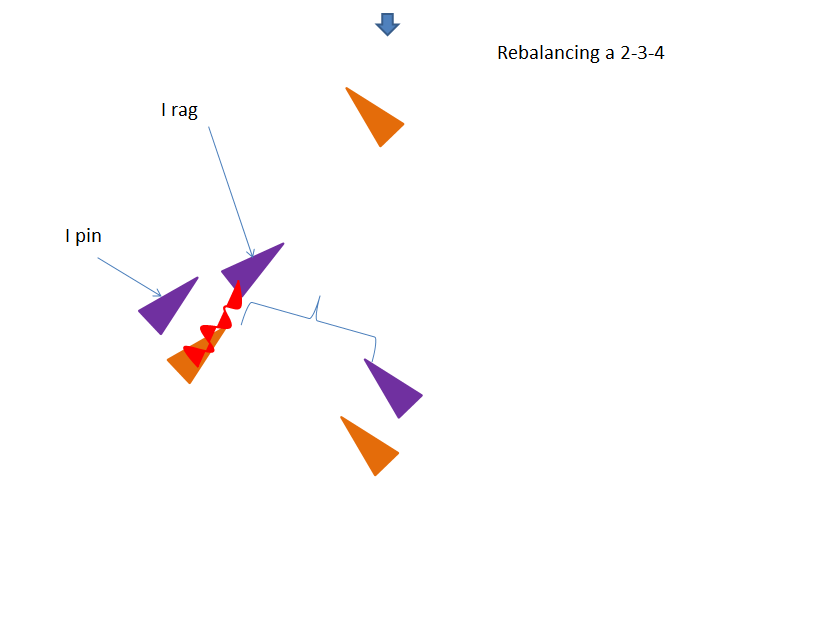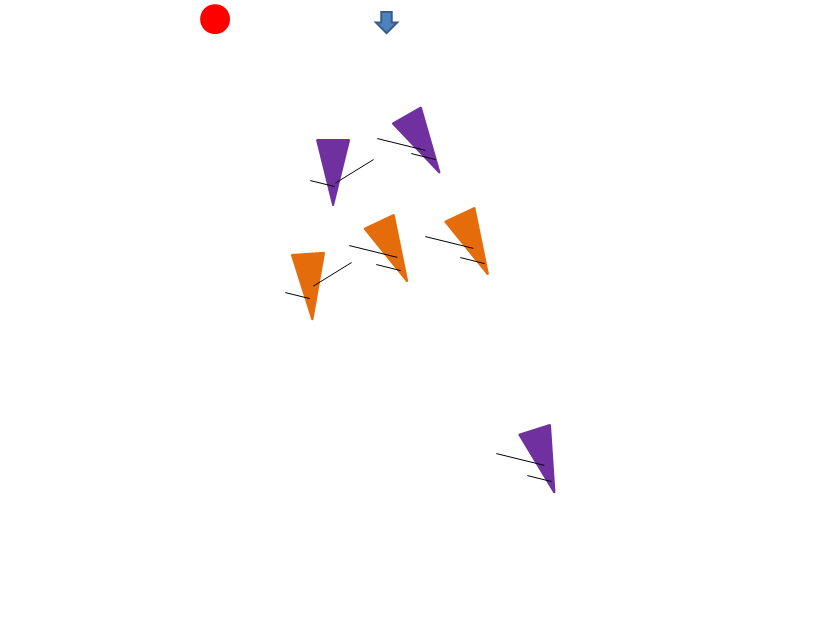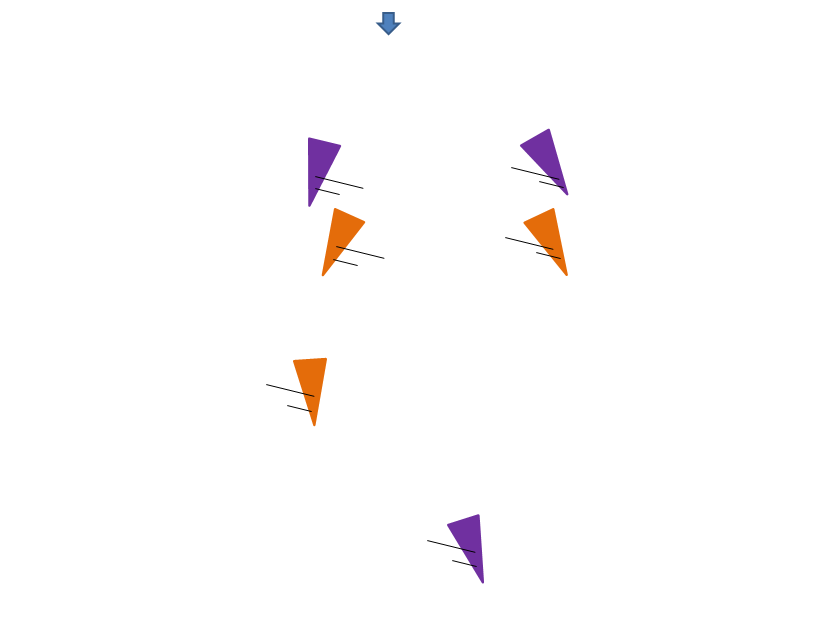Play 2:
2-3-4, 2-3-5, 2-3-6
Play 45:
1-4-5, 1-4-6, 1-5-6
Play 2 Overview:
As mentioned previously, the goal of Play 2 is to finish in a 2-3-4. 2-3-5 will still win, but mostly occurs as a fluke in high level team racing. The reason for this, is that if the other team is in a 1-4-6, the 4th place boat in a will never finish before trying to boost the 6th place boat past the 5th place boat. In other words, a 2-3-5 is a very unstable combination. Thus, in a Play 2, you should never stop executing pass backs until you are in a 2-3-4.
A 2-3-4 is one of the strongest combinations in team racing, assuming that your team can stay balanced with the 5th and 6th place boats on the other team. Play 2 is vulnerable, both upwind and downwind, when the other team is able to move towards two sides of the course, and the pairs are not able to come back together while remaining balanced.
Generally speaking, in a 2-3-4, two boats will gain control of the 5th and 6th place boats on the opposing team, with the third member of the team helping to maintain balance between the pairs, or rescuing a teammate if they lose control of an opposing boat.
Play 45 Overview
Play 45 is less stable than Play 2, but is much less intricate in terms of balance. The biggest mistake made by most teams in Play 45 is the 1st boat running away with the 1, leaving 3 boats vs. 2 boats behind them. It is important that boat 1 retains 1st place. However, they should remain close enough to keep one boat occupied, and should also remain poised to spring a Play 1, if the opportunity arises.
There exception to this is initially around the first offset leg, and early in the downwind leg. If the 1st place boat lingers too close to the competition on those legs, that leaves the opportunity for the 2-3 to swallow him or her up downwind, and lose the 1 spot in the process. Instead, on off wind legs, boat 1 should stay in a spot where she is just far enough to protect the 1, relying on her teammates to do their jobs. She should set a mark trap at the leeward mark to bring the race together or to prevent 3 boats from ganging up on 2 boats behind her. Her job moves back to normal following the leeward mark trap.
While the 1st place boat’s role is crucial, the most important dynamic of Play 45 occurs between the other two boats. While the exact roles will change slightly depending on the precise combination, the ultimate goal is to put one boat on the other team in last. Once this happens, have one boat (Boat 5) gap this boat separating her as far as possible from the rest of the race, while the other boat (Boat 4) pushes boats 2 and 3 up the course.
1-4-5 vs. 2-3-6
These are far and away the most interesting combinations to pair against each other in team racing. In each of these combinations, each boat has a specific role, and the winner of the race is determined by which team executes their roles most efficiently.
Boat 1:
Hold onto the 1 spot, but stay close and connected, keeping boat 2 as uninvolved as possible from the play behind them. Wait to spring a Play 1 if the situation presents itself. On upwind legs, look for opportunities to pin boat 2, to keep them from helping the team balancing.
Boat 4:
Push boats 2 and 3 up the course. Your job is to get as far ahead of boats 5 and 6 as possible, making it more difficult for boats 2 and 3 to boost boat 6 without leaving open a Play 1 opportunity. If you are far enough separated, and boats 2 and 3 split to free up boat 6, move immediately to Play 1.
Boat 5: Your job is simple. Gap boat 6, taking them as far away from the rest of the fleet as possible. There are several reasons to do this. The biggest reason is to keep boats 2 and 3 from having the ability to rescue boat 6. If one of them goes back to help, they will leave a 1-3 in the front of the fleet, which is easy to convert to a 1-2. Another reason you do this, is to act as an insurance policy if your team loses the 1 spot. If this happens, you will automatically have an opportunity to move into a Play 2.
4-5 Wins:
Boat 2:
You need to work with boat 3 to significantly slow boat 4 moving her as close to boats 5 and 6 as possible. If the boats are all about even with each other, boat 2 and boat 3 will each be able to gain control of boats 4 and 5 without giving up their respective positions. From here you will run the necessary pass backs to move into a 2-3-4. Typically, you will want to move boat 6 into 2nd place.
As boat 5 will typically attempt to gap boat 6, boats 2 and 3 will need to double team boat 4, making her go much slower than boat 5 is capable of slowing boat 6. Upwind, this will consist mostly of one boat ragging, while the other is pinning. Downwind, this will consist of a lot of teamwork, hooking boat 4 whenever possible. If she breaks overlap with one of the boats and forces her downwind, the other boat should take over while the other reestablishes overlap with a couple of jibes, etc.
Boat 3:
See Boat 2; the jobs are identical, as the two boats work as a unit.
Boat 6:
You need to get to your help. Boat 5 will try to gap you, and your job is to make this as difficult as possible. Break overlap quickly downwind and force the gapping boat to sail forward. Do not get hooked if you can help it, and do not let them take you out as a starboard boat. When sailing upwind, avoid getting pinned, unless you are sailing toward your help. Avoid a significant amount of tacking. In desperate situations, you may have to jibe out of a pin to keep moving the race forward, but you should avoid this as much as possible. Rely on your teammates to do their jobs, and they will spring you if you are able to keep pushing up the course.
2-3 Wins:

2-3-4 vs. 1-5-6
When these two combinations square off, there is a constant struggle between 2-3-4 remaining balanced, and boats 5 and 6 unbalancing the 2-3-4, gaining control of one opposing boat, and putting them in last.
Boat 2:
For the majority of the race, you are in a position where you are helping maintain balance between the pairs behind you, breaking ties whenever your teammates lose control of a boat, etc.
If you are in the 2 spot immediately around the mark, your role will change slightly. In order to keep the race moving forward, you are in charge of protecting boat 4 from the trailing boats.
Boat 3:
For the majority of the race, your job is to gain control of and balance boat 5. Bring boat 5 towards boat 6 as often as possible by ragging on boat 5 whenever they sail away from boat 6, and pinning her at full speed when you sail towards boat 6.
If you are in the 3 spot immediately around the mark, your role will change slightly. In order to keep the race moving forward, you are in charge of protecting boat 4 from the trailing boats.
Boat 4:
For the majority of the race, your job is to gain control of and balance boat 6. Bring boat 6 towards boat 5 as often as possible by ragging on boat 6 whenever they sail away from boat 5, and pinning her at full speed when you sail towards boat 5.
If you are in the 4 spot immediately around the mark, your role will change slightly. You will sail dead downwind, pushing the race forward much more quickly, forcing boats 5 and 6 into the control of your teammates. When you eventually move into the 2 spot, you will assume that role.
2-3-4 Sailing Downwind
--
Boat 1:
You mostly have to remain patient, staying relatively close on upwind legs, preventing boat 2 from helping her teammates whenever possible. Set leeward mark traps to bring the group together, and possibly break up the 2-3-4. If you try to do too much, particularly downwind, you will risk losing the 1st, and will leave an opportunity for the other team to move to an easy Play 1.
Ultimately, your largest priority is holding onto the 1st, while staying close enough to occupy boat 2, and keep them from doing their job whenever possible.
Boat 5:
You are working with boat 6 to catch one boat from the other team, quickly putting them in last. Look for any and all opportunities to get the other team unbalanced. Split with your teammate whenever possible, forcing them to work to stay in a 2-3-4. On downwind legs, you will sail high to force an opponent to sail a lot of distance to control you. This will give your teammate an opportunity to go low and pass one of the boats on the other team.
Boat 6:
Your job is similar to boat 5’s. You will be the low boat in a high/low downwind. Upwind, when you split up, force the boat that covers you to do a bunch of tacks, or anything else you can do to slow them down. This will give your teammate an opportunity to pass the boat covering you, and you will have a chance to run a pass back from there.
See you on the water,
Zim Coach













No comments:
Post a Comment
Note: Only a member of this blog may post a comment.